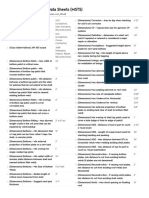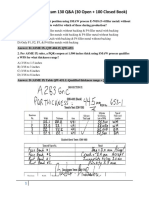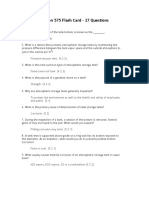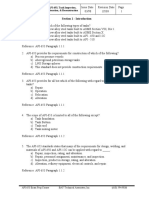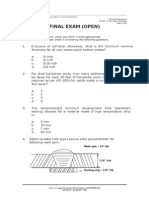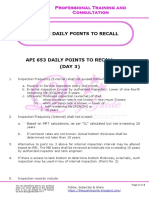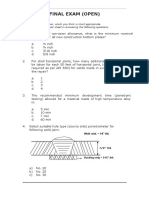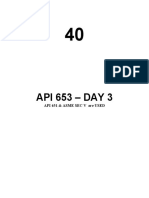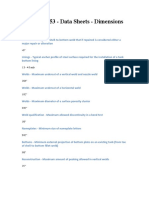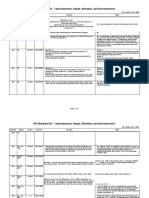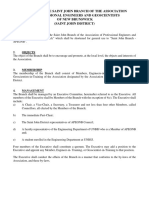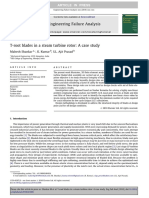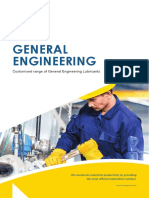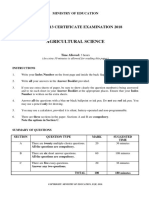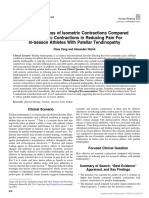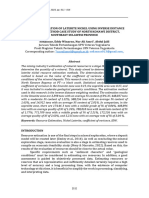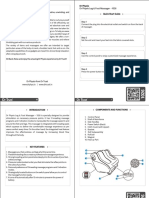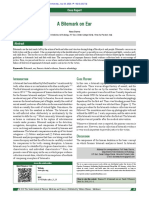API 653 Certification
Data Sheets
Answer
Reference Documents
Reference
API 579
653: 1.1.6
Fitness for Service (FFS)
API 580
653: 6.4.2.2.2
Risked Based Inspection
API 620
653: 2.1
Low Pressure Storage Tanks
API 651
653: 6.3.4.1
Cathodic Protection
API 652
653: 4.4.3.4
Tank Bottom Linings
API 2201
653: 9.14.2
Welding on In-Service Equipment containing Flammables
ASME Sect
V
650: 8.1.3.1,
8.2.1, 8.3.2.2,
8.4.1
NDE Procedure Guidelines
ASME Sect
8, Div 1
650: 8.1.5
Acceptance Standards for RTs of Welds
ASME Sect
8, Div 2
653: 4.3.3.6
Alternative evaluation for pits and LTAs
10
ASME Sect
IX
653: 11.1.1
Welder Qualification
11
ASME Sect
IX
653: 11.1.1
Weld Procedure Qualification
12
ASTM
A370
650: 4.2.8.7
Impact Testing Method and Equipment Requirements
13
AWS
653: 7.4
Requirement for new welding electrodes
14
ASNT SNTTC-1A
650: 8.1.3.2,
8.3.2.4
NDE Personnel Qualification (RT & UT Flaw Detection)
15
Appendix F
653: 4.2.4.1
API 650 Appendix for Frangible Roofs
16
Appendix M
653: 4.2.4.3
API 650 Appendix for Hot Tanks
Answer
1
AIRR
653: 1.1.1
JUIC
653: 3.3
JOC
653: 3.3
MSTS
Class Abbreviations
Reference
API 653 Scope (Alteration, Inspection, Repair, Reconstruction)
API 653 AIs Employer (Jurisdiction, User, Insurance
company, Contractor)
API 653 Repair Organization (authorized by Jurisdiction,
Owner, Contractor)
October 2013
�API 653 Certification
Data Sheets
Answer
Dimensions
Reference
Definitions - Length of shell-to-bottom weld that if repaired is
considered a major repair or alteration
Linings - Typically anchor profile of steel surface required for
the installation of a tank bottom lining
> 0
1.5 4.0
mils
1/64
650: 8.5.2.b
Welds - Maximum undercut of a vertical weld & nozzle weld
1/32
650: 8.5.2.b
Welds - Maximum undercut of a horizontal weld
3/32
650: 8.5.2.c
Welds - Maximum diameter of a surface porosity cluster
1/8
IX: QW-163
Weld Qualification - Max allowed discontinuity in a Bend Test
5/32
650: 10.1.1
653: 13.1.1
Nameplates - Minimum size of nameplate letters
3/8
653: 4.4.5.7
Bottoms - Minimum external projection of bottom plate on an
existing tank (from toe of shell-to-bottom FW)
1/2
653: 10.5.4
Reconstruction - Max amount of peaking allowed in vert welds
10
> 1 or 2t
653: 4.3.3.1
(definitions)
11
653: 9.3.2.3
12
V: T-642.b
13
V: T-741.1.b
14
653: 10.5.5
15
650: 5.1.3.5
16
650: 5.4.2
17
650: 8.6.5
18
653: Fig. 9.13
19
653: Fig. 9.13
Shell Calcs When calculating tmin for shell LTA, minimum
distance away from a weld where E is always 1.0
Shell Patch - Minimum overlap of shell lap-patch used to cover
a hole (edge of hole to edge of patch)
NDE - When performing a PT examination, minimum distance to
clean beyond the area to be examined
NDE - When performing a MT examination, minimum distance
to clean beyond the area to be examined
Reconstruction - Maximum amount of banding allowed in a
horizontal welds
Bottoms - Minimum overlap required for single-welded lap
joints
Bottoms - Minimum external projection of bottom plate on a
new tank
Vacuum Box - Minimum overlap of previously test surfaces
when using a vacuum box
Bottom Patch - Minimum overlap of bottom lap-patch used to
cover corroded area (edge of corrosion to edge of patch)
Bottom Patch - Minimum distance bottom lap-patch fillet weld
to the nearest existing bottom weld
20
653: 9.3.1.4
21
653: 10.3.2.1
22
653: 10.3.4.1
MSTS
653: 3.18.g
652: 7.5
Shell Patch - Minimum radius of a shell lap-patch
Reconstruction - If reusing bottom plates, min distance to cut
from existing bottom welds (if plates are not deseamed)
Reconstruction - If reusing roof plates, min distance to cut
from existing roof welds (if plates are not deseamed)
October 2013
�API 653 Certification
Data Sheets
Answer
Dimensions (continued)
Reference
Shell Pitting - Maximum allowed vertical length of pits on a
tank shell
Bottom Pitting - Maximum allowed length of pits in the critical
zone that can be repaired by weld-buildup
23
2 in 8 line
653: 4.3.2.2.b
24
2 in 8 arc
653: 9.10.1.6.a
25
653: 3.10
Bottoms - Radial length of critical zone measured from shell
26
3-4
650: B.3.2
Bottoms Suggested pad thickness
27
650: 8.5.2.c
Welds - Min distance between clusters of surface porosity
28
653: 9.3.1.7
Shell Patch - Minimum dimension of a shell lap-patch
29
653: Fig 9.1 R
dimension
Shell Patch - Minimum radius of a shell flush-patch
30
653: 4.3.4.1
31
653: 9.10.1.1.b
32
653: Fig 9.9 or
9.10.1.2.b
33
653: 10.3.3.1.c
34
650: 8.1.2.8
653: 12.2.1.7
35
IX: QW-302.2
IX: QW-304.1
36
IX: QW-302.2
37
653: 9.3.1.5
38
6 12
575: 7.2.10
Corrosion Area to dig when checking for soil-to-air corrosion
39
6 - 24
577: 9.3.1.e
NDE Distance of eye-to-part to count as a Visual Exam
40
6 x 30
650: 8.6.1
Vacuum Box - Typical size of a vacuum box
41
12
653: 9.2.2.1
Shell Patch - Minimum dimension of a shell flush-patch
42
12
650: 5.1.5.4.2
43
12
653: 9.10.1.1.a
44
12
650: B.3.1
MSTS
Shell Calcs When calculating tmin for shell LTA, minimum
distance away from a rivet where E is always 1.0
Bottom Patch - Minimum size of bottom lap-patch that does
NOT cross a bottom seam
Bottom Patch - Minimum distance between a bottom lap-patch
and the shell for patches that do NOT extend to the shell
Reconstruction - If reusing shell plates, min distance to cut
from existing shell welds (if plates are not deseamed)
RT - Minimum diagnostic length of a RT for vertical or
horizontal welds
Weld Qualification - Minimum length of RT when qualifying a
welder with RT using a coupon or 1st production weld
Weld Qualification - Minimum length of RT when qualifying a
welding operator with RT of a test coupon
Shell Patch Minimum distance to overlap a shell weld when
using a lap-patch
Bottoms - Minimum dimension that a 3-lap joint can be from:
other 3-laps, the shell, or annular plate joints
Bottom Patch - Minimum dimension of bottom lap-patch that
crosses a bottom seam
Foundations - Suggested height above grade for new tank
bottoms
October 2013
�API 653 Certification
Data Sheets
Answer
Dimensions (continued)
Reference
Shell Patch - When adding a shell flush-patch that extends to
a horizontal shell weld, minimum distance to cut the
horizontal weld past the new vertical welds
Shell Patch - Dimension of a shell flush-patch that is
considered either a major repair or alteration
Definition - Dimension of a shell vertical weld if repaired or
replaced is considered a major repair or alteration
45
12
653: Fig 9.1
Note 2
46
> 12
653: 3.19.c
47
> 12
653: 3.19.e
48
24
653: Fig 9.13
Note 3
Bottom Patch Max width of bottom patch in the critical zone
49
24
650: 5.1.5.4.3
& 5.5.2
Bottoms - Minimum radial width of annular plate (distance
between shell and nearest bottom fillet weld)
50
24
575: 8.2.1
NDE Max distance of eye-to-part to count as a Visual Exam
51
36
653: 9.14.1.2
52
36
IX: QW-305.1
53
36
653: 10.5.4 / 5
54
36
650: 9.4
11.2.2
55
48 x 72
653: 9.3.1.7
56
10
653: Fig B.2
57
10
650: C.3.1.6
Roofs Maximum shunt spacing on floating roof
58
32
653: Fig B.1 /
12.5.1.2
59
50
653: 12.2.1.2
b&c
Settlement - Maximum distance between tank settlement
survey points around the outside diameter of the tank
NDE - Maximum distance between RTs in horizontal welds
when welding to existing shell plates
60
< 60
651: 6.2.1
CP Typical tank size for Galvanic CP systems
61
> 200
62
5t
650: 5.1.5.2.b
63
Full Fillet
650: 5.1.5.4.3
MSTS
653:
653: 4.3.3.4
Hot Tap - Minimum height of liquid above new nozzle during
the hot tap operation
Weld Qualification - Minimum length of RT when qualifying a
welding operator with RT of first production weld
NDE - Length of sweep board used when checking for banding
or peaking
Welds - Maximum distance between welder ID stamps on a
tank weld
Shell Patch - Maximum size of shell lap-patch (vertical &
horizontal dimensions)
Settlement - Maximum distance between tank settlement
survey points across the inside of the tank
Shell Calcs - Tank diameter when variable point design method
should always be used to calc shell minimum thickness
Shell Minimum offset between vertical welds in adjacent
courses
Bottoms Minimum size of bottom welds
October 2013
�API 653 Certification
Data Sheets
Answer
1
2
3
< 2 NPS
> 2 NPS
3 NPS
(3-1/2 O.D.)
4 NPS
> 12 NPS
Answer
Line Sizes
Reference
650: 5.7.2.1
653: 9.8.6
V: T-271.2.b
653: 9.14.1.1.b.1
653: 3.19.a
Repad - Nozzle size that never requires a repad
Repairs On existing tank, new nozzle must use insert plate if
shell is over thick and shell material does not meet
current MDMT requirements
RT - Maximum pipe size when using a RT elliptical shot (doublewall technique, double-wall view)
Hot Tap - Maximum nozzle size that can be hot tapped when
course thickness is > and shell has unknown toughness
Definition - When adding a new nozzle, nozzle size to be
considered a major alteration
Percentages
Reference
RT Film Density - Limits of weld as compared to the IQI
(range)
AI Amount of time inspector must be involved in inspection
activities - required to maintain API 653 certification
RT Reconstruction - % to of weld intersections (new welds to
old welds) to be RTd
Maximum relative humidity when performing abrasive blasting
for tank bottom linings
-15 to +30%
V: T-282.2.a
20%
653: D.5.2.a
25%
653: 12.2.1.5
80%
652: 7.4
80%
652: 8.3
Maximum relative humidity when installing tank bottom linings
100%
653: 12.2.1.8
% to RT when installing a new insert plate with a nozzle into an
existing shell plate
MSTS
October 2013
�API 653 Certification
Data Sheets
Answer
Temperatures
Reference
< 0 oF
653: 10.4.2.3
Reconstruction - Base metal temp where welding is not allowed
0 - 32 oF
653: 10.4.2.3
Reconstruction - Base metal temp when hand-warm pre-heat is
required
652: 7.4
Linings - Minimum temp when performing abrasive blasting
652: 8.3
Linings - Minimum temp when installing tank bottom linings
3
4
5 oF above
dew point
5 oF above
dew point
Corrosion The corrosion rate of steel tank bottoms may
double with this rise in temperature
UT Calibration - Calibration Block must be within what
temperature of the part to be examined
18 oF
651: 5.4.1 Note
25 oF
577: 9.9.1
40 - 125 oF
650: 8.6.6
Vacuum Box - Standard temperature range for VB exam
40 - 125 oF
V: T-652/653
PT - Standard temperature range for a PT exam
< 50 oF
650: 9.2.2.3
10
> 60 oF
653: Fig 5.1
11
> 100 oF
653: 9.10.1.2.3
12
< 110 oF
653: 6.4.2.1.2.1
13
140 oF
653: 10.4.2.3
Preheat - Approximate temp of a required hand-warm pre-heat
14
> 150 oF
571: 4.3.10.6c
575: 7.4.3
15
200 oF
653: 10.4.4.3
16
> 200 oF
Corrosion - Temperature when high strength caustic causes
serious corrosion in CS and 300 SS
Preheat - Required pre-heat temperature for shell welds over
1.5 thick during Reconstruction
Bottom Lap Patches - Metal temperature where lap-patches
are NOT allowed in the critical zone on CS tanks
17
200-500 oF
653: 9.10.1.2.3
Impact Test - Design metal temperature that requires weld
procedure used for vertical welds to be impacted tested
Brittle - Tank metal temperature where brittle fracture is
NOT a concern
Bottom Lap Patches - Metal temp where lap-patches are NOT
allowed in critical zone on SS tank
Intervals - If tank product solidify below this temperature,
the code maximum interval rules do not apply
650: 1.1.20
Temperature Range for API 650 App M
Corrosion - Most aggressive temperature range for CUI.
Range for API 575 and API 571
Preheat - Minimum pre-heat temperature, when pre-heat is
substituted for PWHT
18
120 200 F
212 - 250 oF
575: 7.2.7
571: 4.3.3.3.d
19
300 oF
653: 11.3.1.d
20
1000 oF
V: SE-797 8.5
Maximum temperature for UT readings
21
1100-1200 oF
650: 5.7.4.1/2
PWHT Temperature
22
MSTS
October 2013
�API 653 Certification
Data Sheets
Answer
Thicknesses
Reference
< 0.020
0.050
653: Table 4.4
0.050
653: Table 4.4
0.090 in
100 in2
0.100
653: 4.3.3.1.b
(definitions)
0.100
653: 4.4.5.7
0.100
653: Table 4.4
0.100
653: 9.10.1.6.b
0.100
653: 9.13.6.2
Roof Rim - Minimum allowed roof rim thickness
10
3/16
650: 5.10.2.2 &
C.3.3.2
653: 9.11.2.1 &
9.11.3.1
Roof - Minimum thickness of new roof plate (cone & floating)
11
3/16
653: 9.13.6.2
Roof Rim - Minimum thickness of new roof rim
12
1/4 ( 0.236)
650: 5.4.1
Bottom - Normal minimum thickness of new bottom plate
13
1/4
653: 9.10.1.2.a
Bottom Patch - Maximum thickness of lap-patch in critical zone
14
1/2
653: Fig. 5.1
Brittle - Thickness when brittle fracture is NOT a concern
15
1/2
653: 9.3.1.2
Shell Patch Max shell thickness when lap-patches are allowed
16
1/2
653: 9.3.1.3
Shell Patch Maximum patch thickness for a shell lap-patch
17
> 1/2
IX: QW-191.
2.1.a
18
> 1
653: 12.1.5.1.
19
> 1
650: 8.1.2.2.c
20
> 1-1/2
653: 10.4.4.3
Weld Qualification When can UT be used in lieu of RT to
Qualify a Welder/Welding Operator
NDE - When welding existing shell plate. Thickness that
requires 100% examination by RT and MT or PT.
NDE - Plate thickness which requires 100% of verticals weld to
be radiographed
Reconstruction - Shell plate thickness that requires all welds
to be preheated to at least 200 oF.
21
tmin
653: 4.3.2.2.a
MSTS
652: 3.33
653: 4.2.1.2
Linings - Thickness of a thin film lining
Bottom - Minimum allowed bottom plate thickness when there
is a Reinforced Liner that is > 0.050 thick
Bottom - Minimum allowed bottom plate thickness when there
is a means to Detect and Contain a leak
Roofs - Minimum allowed average thickness of corroded roof
plate
Shell - Minimum arbitrary shell thickness (used when
calculated minimum thickness is below this number)
Bottom - Minimum allowed thickness of bottom plate at toe of
the external shell-to-bottom fillet weld
Bottom - Minimum allowed bottom plate thickness away from
critical zone or an annular plate
Bottom - Minimum allowed plate thickness in critical zone that
can be repaired by weld-buildup
Shell Pits - Minimum remaining thickness allowed below a pit
October 2013
�API 653 Certification
Data Sheets
Answer
Time Intervals
Reference
5 seconds
650: 8.6.8
Vacuum Box - Minimum duration of each vacuum-testing exam
5 minutes
V: T-676.4.b
& T-777.2.b
10-60
minutes
4 hour
24 hour
653: 12.3.1
NDE - Minimum time an examiner should be in a darkened area
prior to using a black light for MT & PT exams
NDE - Final interpretation of a PT exam after application of
developer (time range)
Testing - Minimum time to let oil to penetrate when performing
a diesel oil test of shell-to-bottom weld
Testing - Minimum duration for a tank hydrotest to be held at
full height
1 day
V: T-762(a)
NDE - Max Calibrating Interval - Permanent magnet MT Yoke
1 month
653: 6.3.1.2
Intervals - Maximum Interval - Routine In-Service inspection
2 months
651: 11.3.2.2
CP - Maximum Interval - Routine check of CP impressed
current sources
90 days
V: T-262.1
NDE - Max Calibrating Interval - RT densitometer
10
180 days
653: 8.4.1
11
6 months
IX: QW-322.
1.a
12
1 year
V: T-762(a)
13
1 year
651: 11.3.2.3
14
1 year
651: 11.3.1.2
15
1 year
653: 13.2.3.d
16
1 year
650: 8.6.4.a
Vac Box Max Test Interval - Jaeger 2 eye test for VB oper
17
1 year
650: 8.2.3/8.4.3
NDE Max Test Interval - Jaeger 2 eye test for PT/ MT tech
18
3 year
653: D.5.1
AI Time period between API AI recertification
19
5 year
653: 6.3.3.2.a
Intervals - Maximum Interval - UT readings of a tank shell
when the corrosion rate is unknown
20
Lesser 5 yr
or life
653: 6.3.2.1
Intervals - Maximum Interval - External Inspection
21
6 year
653: D.5.3
AI Time period between API AI on-line recertification
22
10 years
653: 6.4.2.1
Intervals - Maximum Interval - Initial Internal Inspection
(without RBI or other special situations)
MSTS
V: T-676.1
650: 7.2.4.1.d
& 653: 12.1.6.1
Reconstruction - Maximum allowed age of last thickness
readings, used to design a reconstructed tank
Weld Qualification Maximum Time - Welder or operator
maintains qualifications for a welding process without
using that process
NDE - Max Calibrating Interval - Electromagnetic MT Yoke
CP - Maximum Interval - Detailed check of CP impressed
current facilities
CP - Maximum Interval - CP surveys (field potential
measurements)
NDE - Minimum Time - To keep RTs acquired during tank
repairs and reconstructions
October 2013
�API 653 Certification
Data Sheets
23
24
25
Answer
Reference
10 years
653: 6.4.2.2.2
Lesser 15 yr
or life
20 yr or full
bttm life
653: 6.3.3.2.b
653: 6.4.2.2.1
Time Intervals (continued)
RBI - Maximum Interval - RBI reassessments
Intervals - Maximum Interval - UT readings of a tank shell
when the corrosion rate is known
Intervals - Maximum Interval - Internal Inspection when the
corrosion rate is known (without RBI assessment)
26
> 20 years
652: 6.2.1.c &
6.3.1.f
Linings - Typical life of a properly applied tank lining
27
Before &
after use
V: T-676.4(e) &
T-777.2(e)
NDE - Max Calibrating Interval - Check the light intensity of a
black light used in a MT or PT exam
Answer
Reference
Pressures
650: F.1.3 &
575: 3.3
Scope - Maximum internal pressure for tanks in API 650 & 653
650: 8.6.3
Vacuum Box - Normal vacuum required when vacuum testing
15 psig
650: 7.2.4.2
653: 12.1.6.2
Pressure Test - Pressure used when air testing the shell-tobottom weld
15 psig
650: 7.3.4
Pressure Test - Pressure used when air testing a repad
15 psig
575: 4.3.2
Scope - Maximum internal pressure for tanks in API 620
2.5 psig
3 - 5 psig
Answer
1
1:120
Slopes
Reference
650: 5.4.4
Minimum slope of normal tank bottom
1:16
650: 5.10.4.1
Minimum slope of cone roof tank (for water runoff)
2:12
650: 5.10.2.6.a.1
Maximum roof slope on tanks > 50 diameter (if roof is
considered to be fragible)
1:4
650: 5.7.1.7
653: 9.8.4.a
Maximum taper (steepest slope) allowed for an insert plate
MSTS
October 2013
�API 653 Certification
Data Sheets
Answer
Miscellaneous Numbers
Reference
Roofs - Maximum amount of primary seal that can be removed
for repair while tank is still in service
NDE - Minimum number of RTs required on a circular shell
replacement plate
1/4
1.0
653: Table 4.2
1.0
653: 4.3.4.1
1.0
653: 4.3.3.1
E defined
653: 10.3.5.2
IX: QW451.1
IX: QW452.1.a
V: T-271.2.b.1
10
2.0 4.0
11
V: T-271.2.a
12
650: 4.2.9.3
13
V: T-277.3
14
653: 9.14.3.2
15
IX: QW451.1
Weld Qualification - Number of bend tests to qualify a WPS
16
IX: QW452.1.a
Note 1
17
653: 4.3.2.1.c
18
653: 12.2.1.6.2
19
653: 12.5.1.2 &
Fig B.1
Weld Qualification - Number of bend tests required to qualify
a welder in welding positions 5G & 6G
FFS - Corrosion Averaging in a Shell LTA - Minimum # of UT
readings to take on each designated vertical line.
NDE - Minimum number of RTs required on a square or
rectangular shell replacement plate
Settlement - Minimum number of settlement points around
circumference
653: 9.13.1
653: 12.2.1.6.1
V: T-282.1
FFS Current joint efficiency E in API 650
FFS Joint Efficiency E Calculating tmin for an LTA, when
LTA is away from rivets by > 6
FFS Joint Efficiency E Calculating tmin for an LTA, when
LTA is away from weld by greater of: 1 or 2t
Reconstruction - Number of sets of center punch marks
located on top and bottom edges of each shell piece
Weld Qualification - Number of tension tests to qualify a WPS
Weld Qualification - Number of bend tests to qualify a welder
or welding operator in welding positions 1G-4G
NDE - Minimum # of exposures to RT 360o of a weld using a
double-wall technique, double-wall view (elliptical shot)
NDE - RT film Density Range - allowed for the weld & IQI
when using a gamma ray source
NDE - Minimum # of exposures to RT 360o of a weld using a
double-wall technique, single-wall view
Impact Test - Number of test bars required in each set of
impact test specimens
NDE - When using a shim under a hole-type IQI, the number
of sides of the IQI that must be seen in the RT image
Hot Tap - Minimum number of UT readings around the
circumference of a new hot tapped nozzle
20
21
22
MSTS
10
October 2013
�API 653 Certification
Data Sheets
Answer
Reference
Miscellaneous Other
1/100
height
653: 10.5.2.1
Reconstructed Maximum allowed out-of-plumbness
< 5.0 pH
651: 5.3.2.1.g
Corrosion pH level that causes corrosion to increase
10 ppm
651: 5.3.2.1.h
Corrosion Chloride level where pitting on steel begins
10 lb.
V: T-762.b
NDE - Weight used to check magnetic strength of an AC yoke
25 ohm
575: 7.2.5
Grounding - Maximum electrical resistance permitted from
tank to earth
30 degrees
575: 8.2.1
577: 9.3.1
NDE Min angle of eye-to-part to count as a Visual Exam
40 lb.
V: T-762.c
NDE - Weight used to check magnetic strength of a DC yoke
100 ftcandles
V: T-676.3 &
T-777.1
NDE - Minimum light intensity when performing nonfluorescent MT or PT exams
100 ftcandles
650: 8.6.7
Vacuum Box - Minimum light intensity when performing vacuum
testing
10
1000 microW/cm2
V: T-676.4.c &
T-777.2.c
NDE - Minimum black light intensity when performing
fluorescent MT or PT exams
11
< 7000 psi
653: Fig 5.1
Brittle Shell stress when brittle fracture is NOT a concern
12
2T
V: T-283.1
NDE - Hole size that must be visible in RT when using a holetype IQI
13
2T
IX: QW451.1
Weld Qualification - Maximum allowed thickness on a WPS
based on the plate thickness (T) of a PQR test coupon
14
6G
IX: QW461.9
Weld Qualification The all-position test coupon
15
V: T-223
NDE - Lead letter used during RT to check for backscatter
radiation
16
V: T-277.1.b
NDE - Lead letter used during RT to indicate a film-side IQI
17
653: 12.2.3.2
NDE - Lead letter used during RT to indicate a repaired weld
18
P-1
653: 11.3.1.a
Repairs Material where pre-heat can be substituted for a
required PWHT
19
P1, P3, P4
653: 11.3.2.a
Repairs Materials where control deposition welding can be
substituted for a required PWHT
20
Ext Strong
653: Fig 9.10
Hot Taps Nozzle thickness for hot tapped nozzles
MSTS
11
October 2013
�API 653 Certification
Data Sheets
Answer
Reference
Miscellaneous Other (continued)
21
SMAW,
GMAW,
FCAW,
GTAW
653: 11.3.1.b
653: 11.3.2.b
Repairs Welding processes that can be used when
substituting Preheat or Controlled Deposition welding for
a required PWHT
22
Anode
651: 4.1.1.a
Corrosion In a corrosion cell, the part that corrodes
23
Cathode
651: 4.1.1.b
Corrosion In a corrosion cell, the part that doesnt corrode
652: 7.1
Linings Minimum surface prep prior to applying lining
IX: QW191.2.
3.a
Weld Qualification Rejectable in RT when qualifying a welder
24
25
NACE 2
Near-white
Crack, LoF,
IP
26
MSTS
12
October 2013
